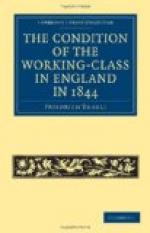A mile eastward lies Stalybridge, also on the Tame. In coming over the hill from Ashton, the traveller has, at the top, both right and left, fine large gardens with superb villa-like houses in their midst, built usually in the Elizabethan style, which is to the Gothic precisely what the Anglican Church is to the Apostolic Roman Catholic. A hundred paces farther and Stalybridge shows itself in the valley, in sharp contrast with the beautiful country seats, in sharp contrast even with the modest cottages of Ashton! Stalybridge lies in a narrow, crooked ravine, much narrower even than the valley at Stockport, and both sides of this ravine are occupied by an irregular group of cottages, houses, and mills. On entering, the very first cottages are narrow, smoke-begrimed, old and ruinous; and as the first houses, so the whole town. A few streets lie in the narrow valley bottom, most of them run criss-cross, pell-mell, up hill and down, and in nearly all the houses, by reason of this sloping situation, the ground floor is half-buried in the earth; and what multitudes of courts, back lanes, and remote nooks arise out of this confused way of building may be seen from the hills, whence one has the town, here and there, in a bird’s-eye view almost at one’s feet. Add to this the shocking filth, and the repulsive effect of Stalybridge, in spite of its pretty surroundings, may be readily imagined.
But enough of these little towns. Each has its own peculiarities, but in general, the working-people live in them just as in Manchester. Hence I have especially sketched only their peculiar construction, and would observe, that all more general observations as to the condition of the labouring population in Manchester are fully applicable to these surrounding towns as well.
Manchester lies at the foot of the southern slope of a range of hills, which stretch hither from Oldham, their last peak, Kersallmoor, being at once the racecourse and the Mons Sacer of Manchester. Manchester proper lies on the left bank of the Irwell, between that stream and the two smaller ones, the Irk and the Medlock, which here empty into the Irwell. On the left bank of the Irwell, bounded by a sharp curve of the river, lies Salford, and farther westward Pendleton; northward from the Irwell lie Upper and Lower Broughton; northward of the Irk, Cheetham Hill; south of the Medlock lies Hulme; farther east Chorlton




